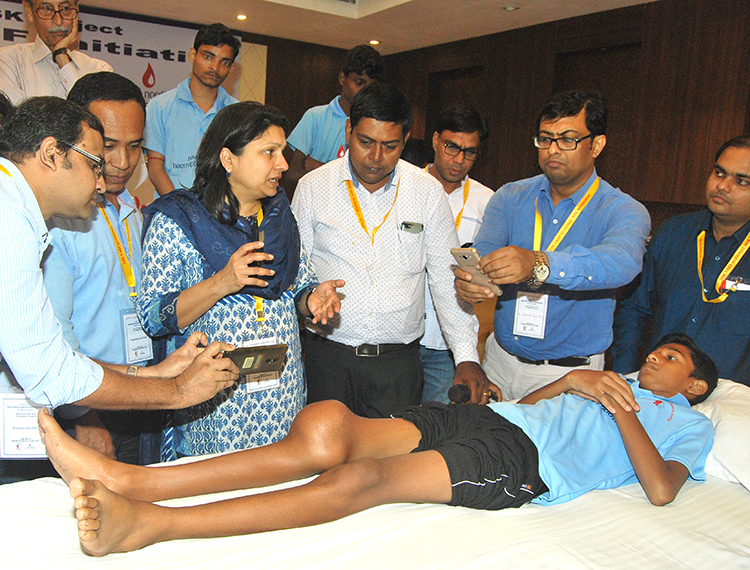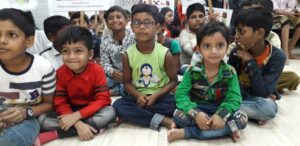World Haemophilia Day: Battling lethal bleeding disorder

In India, 21,824 patients were suffering from different forms of haemophilia in 2019, according to Haemophilia Federation (India) (Photo Credits: Haemophilia Federation India)
When four-year-old Piyush Tanti, slightly injured his forehead while playing, he began bleeding profusely and he had to be hospitalised where his parents were told that there was an urgent requirement of AHF VIII to stop his bleeds and if the bleeding was not stopped in time it would lead to death. Tanti’s minor injury turned near fatal as he suffered from haemophilia factor VIII deficiency.
Like Piyush, over1,125,000 men and approximately 2700 women around the world suffer from this life-threatening bleeding disorder, Haemophilia, a genetic illness that is much more common amongst males, says a report by the American Journal of Managed Care.
Haemophilia impairs the body’s ability to control coagulation or blood clotting, which means that the blood doesn’t clot as it should do normally. In India, 21,824 patients were suffering from different forms of the haemophilia, out of which 21101 were male and 723 female, says a 2019 report by Haemophilia Federation (India), national umbrella organisation in India working for the welfare of persons with this condition.
“The pain that we feel is the biggest thing that stops us from moving forward. It is indescribable, and I can’t even explain it to someone normal you know, only a haemophilic can understand and empathise with that pain,” Abhilash Dalal, a haemophilia patient, who works with Haemophilia Federation (India) as a admin manager, tells Media India Group.
Life of a haemophilia patient
Living with a life-threatening blood disorder, where even the slightest injury can lead to uncontrollable bleeding and may impale the patient for days is extremely challenging.
“Overall, life is miserable with this disease. I suffer from Haemophilia Factor A deficiency, my legs got affected with haemophilia bleeding when I was just eight and they stopped working, I was not able to walk and was completely bedridden for 16 years. It was after a surgery in 2006 that I could walk again,” says Dalal.
“There are a lot of challenges a haemophilic has to face even in his daily life. When you suffer from this disease you lead a restricted life; you can’t perform every task, you can’t just go wherever you want, you can’t play much or travel easily, even trivial tasks like giving an exam can become challenging if you have swellings or bleeding, it becomes very difficult to even write, he added.
The difficulties are borne not just by the patients but also by their caregivers who in most cases have to compromise their own lives to look after the patients and still have to helplessly watch their loved ones suffer.
“I have a 13-year-old son suffering from haemophilia. I have to be around him round the clock as he can get a bleed anytime and may need my assistance. Even though I am doing everything I can, I still feel helpless as I have to watch my son suffer everyday and still cannot do anything to ease his pain,” Anju Verma, mother of a 13-year-old haemophilic boy associated with Haemophilia Federation (India) in Gorakhpur, tells Media India Group.
Treatment
People suffering from this disease can get uncontrollable bleeding even from the smallest injury, and in many cases the bleeding can even occur spontaneously and a blood transfusion or respective factors are required to be administered immediately.
Presently, the best way to treat haemophilia is to replace the missing blood clotting factor so that the blood can clot properly. This is typically done by injecting treatment products, called clotting factor concentrates, into a person’s vein.
“At present we do have options available for treatment, like Factor A concentrates. There is no permanent treatment for this disease; you need to get transfusions or factors whenever necessary. The frequency depends on the person affected and his condition, if you fall or have any kind of injury normally you need immediate transfusion within 5-10 minutes or else the bleeding gets out of hands and may lead to internal bleeding as well. Apart from that you can bleed or get a swelling spontaneously as well and you need transfusions then also,” explains Dalal.
Impact of Covid-19
While the focus of the health care sector has shifted towards accommodating the increasing number of Covid-19 cases, it has resulted in less emphasis on other serious illnesses like haemophilia.
People suffering from this chronic blood disorder are already at a higher risk of developing serious Covid-19 symptoms, lack of accessibility to specialists and the fear of contracting the virus from regular hospital visits have made haemophilia patients even more vulnerable.
“We faced a lot of problems during the lockdown last year, stocks of factor VIII and IX in Gorakhpur, where I reside had finished and therefore the patients also suffered a lot as whenever these patients, especially the kids have a bleed they immediately require these factors or else they suffer from a lot of pain,” says Verma.
Support from government and other organisations
Though the government provides financial support to people suffering from the bleeding disorder and has also launched portals for registration of such patients. Experts say, only 15 pc of Indians suffering from Haemophilia have been identified while the rest lay undiagnosed.
Non-profit organisations like Haemophilia Federation (India) associated with World Federation of Haemophilia also provides aid to patients suffering from the disease, whether it is accessibility to treatment or financial assistance through various projects.
“The government does provide free medicines and a lot of NGOs or an organisation like ours also provides aids to haemophilic patients. The blood for transfusion is also quiet accessible from government hospitals, as far as my experience goes,” says Dalal.










